Nuclear energy: past, present and future
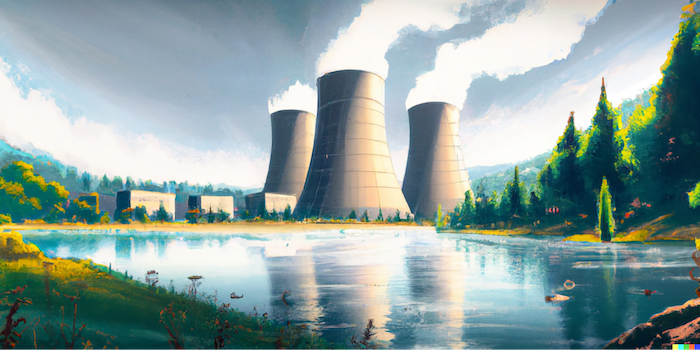
Source: DALL-E
Nuclear energy has been quietly producing carbon-free energy for decades, but most don’t know that it accounts for 20% of the US’s electricity and over half of its carbon-free electricity. It’s been the underdog energy source—rarely celebrated, or worse, villainized, and deeply underinvested in.
The war in Ukraine and subsequent global energy crisis, alongside longstanding concern around climate change, has policymakers grappling with how to ensure energy is reliable, abundant, and carbon-free. Nuclear energy is the only energy source that solves for all three.
So why aren’t we building more?
Starting in the late 1960s, major environmental groups coalesced around an anti-nuclear stance that, echoed by the media, soured public perception. Support from political leaders subsequently waned, and regulatory burden grew. This resulted in cost increases that began to make nuclear less economically competitive, which was further exacerbated by deregulating electricity markets that favored new construction with shorter payback periods. Subsidies for renewables and fossil fuels stacked the deck even more unfavorably for nuclear energy. As a result, the amount of nuclear energy capacity in the United States flatlined in the late 1980s.
Despite these challenges, nuclear energy’s carbon-free, 24/7 qualities make it undeniably attractive to meet the demands of clean, firm power, where both fossil fuels and renewables fall short. There have been a number of promising developments for nuclear energy this year and the ‘why now’ for nuclear is strong.
I’ve written the following to unpack the current state of nuclear energy and its outlook: why it’s been overlooked for so long, what its benefits and challenges are, and what must happen to build more of it.
1. The Rise & Plateau of Nuclear Energy
Nuclear energy got its start with the military in the development of the nuclear bomb. After that, the technology was put to use in the civilian application of electricity generation. Unfortunately, an anti-nuclear movement developed which damaged its reputation and its growth trajectory.
What follows is an abbreviated history of nuclear energy in the U.S. and the anti-nuclear movement that has plagued its existence.
A violent debut turned civilian application
Nuclear fission’s first application in the world was in a pair of atomic bombs that fell on Japan during World War II. Needless to say, the term “nuclear” has some less-than-desirable affiliations. However, the “atoms for peace” agenda of the 1950s meant that soon fission’s powerful properties would be put to civilian use. The first commercial power plant came online in 1958 in Pennsylvania alongside optimistic rhetoric of “energy too cheap to meter” and even direct-to-consumer products like a nuclear car!
Anti-nuke attitudes are born
In the mid-1950s, the US military conducted a hydrogen bomb test in the South Pacific that spread dangerous levels of radiation over inhabited islands. The test also directly affected a Japanese fishing boat, with the crew suffering from radiation poisoning as it sailed back to Japan. Needless to say, this was a PR disaster for nuclear weapon testing, and the Pentagon’s botched cover-up further eroded trust.
Nuclear weapons were also the defining feature of the Cold War, with the Soviets and Americans building stockpiles of WMDs that would destroy the world many times over. Anti-nuke protests proliferated at the height of the Cold War in the early 1960s, in response to both testing and proliferation concerns.
Environmentalists go anti-nuclear
Concurrently, a grassroots environmental movement was starting to take shape in the 1960s. Rachel Carson’s Silent Spring and The Population Bomb were bestsellers, drawing attention to concerns over pesticides and overpopulation. The early 1970s saw the establishment of Earth Day, Greenpeace, and the UN’s Environment program.
Growing in rank, environmentalists began to turn against nuclear energy. Many point to the opposition of the proposed Bodega Bay nuclear power plant as the birthplace of the anti-nuclear environmental movement. Local community groups and environmental groups protested the plant with typical not-in-my-backyard opposition – damage to flora and fauna, to the local character, to fishermen’s livelihoods. They found traction, however, in pointing to the nuclear attributes of the plant and began a campaign, including the launch of 1,500 helium balloons with messages in them, about the dangers of nuclear fallout.
While the Sierra Club had initially been pro-nuclear, some of its outspoken members shifted their stance, fearing the runaway growth such a powerful and abundant energy source might cause. David Brower, Executive Director of the Sierra Club, was deeply concerned with overpopulation and immigration: “More power plants create more industry, that in turn invites greater population density…the state’s scenic character will be destroyed.”
Eventually, the Sierra Club flipped its position, and to this day it and the rest of the major environmental groups hold an anti-nuclear stance. They have worked for decades now to close down nuclear plants, establish moratoria against new plants, and generally foster unjustified fear of nuclear energy.
“Disaster-ous” misunderstandings
Nuclear energy’s reputation has been dealt several major blows by the nuclear disasters of Three Mile Island (1979), Chernobyl (1986), and Fukushima (2011). Overblown response and media coverage to each of these events led to a vast misunderstanding of what happened at these events, and how damaging they actually were.
The accident at Three Mile Island in 1979, for example, killed a total of zero (0) people. The incident released negligible amounts of radioactivity — the estimated dose of radioactivity experienced in the local area is equivalent to ⅙ of the amount you’d get with a chest x-ray, and far below the level of background radiation typically experienced in a year.
However, the dramatic evacuation response, permanent shutdown of the reactor, and lack of clarification or attempts to accurately report what actually happened means many Americans still believe Three Mile Island to be a true “disaster” and reason to ban nuclear power plants. It didn’t help that Jane Fonda’s film China Syndrome, depicting a horrific nuclear meltdown, had debuted 12 days earlier.
Two other accidents, Chernobyl in 1986 and Fukushima in 2011, are similarly misunderstood, and Fukushima in particular, blown quite out of proportion. Chernobyl was operating without today’s safety standards. The plant didn’t have a containment dome, which would have helped to prevent the escape of radioactivity. Even more shocking is what caused the accident: the operating team was running an “experiment” that involved switching off automatic safety mechanisms and simulating an emergency. They did this without training or planning. The initial steam explosion killed 3, while 28 firefighters died from acute radiation syndrome (ARS). 15 died from thyroid cancer in the first 25 years after the accident.
The nuclear plant Fukushima Daichi suffered a meltdown from the flooding induced by the tsunami, however only 0 or 1 people died from the accident, with far more damage and loss of life caused by the overblown evacuation response to the accident. The earthquake that caused the tsunami that led to the Fukushima meltdown was the largest in its recorded history, leading to over 15,000 deaths and a massive toll on the built environment of Japan, including many industrial areas.
Despite these accidents, when compared to other industries, nuclear energy is very safe (more below).
2. Why go nuclear?
Nuclear energy is a powerful form of carbon-free energy that is:
- Safer and cleaner than fossil fuels
- More consistent and reliable than renewables
- Space and resource efficient
Carbon-free
Nuclear energy, as well as solar, hydro, wind, and geothermal — collectively known as “renewables” — produce no carbon emissions. In a world reckoning with the current and future impacts of climate change and committing to aggressive emissions reductions goals, zero-emissions is a powerful benefit.
Available 24/7
People are used to the lights coming on every time they flip a switch, so generation needs to be ready to meet consumer demand no matter what the time of day or what the weather is doing. To meet this demand, the electric grid needs access to power that is consistently and reliably produced and does not depend on whether the wind is blowing or the sun is shining.
Solar’s capacity factor, or roughly the % of the time it is producing electricity, is 17–28%. There is also significant variation in output, e.g. nothing at night when there is no sun out. Wind’s capacity is about 32–47%. A grid of majority renewables with the battery and storage technology we currently have would fail to provide the supply of electricity the grid demands due to the intermittent nature of the generation. Nuclear’s capacity factor of 90+% makes it a fantastic source of baseload power – power that is constantly and reliably available.
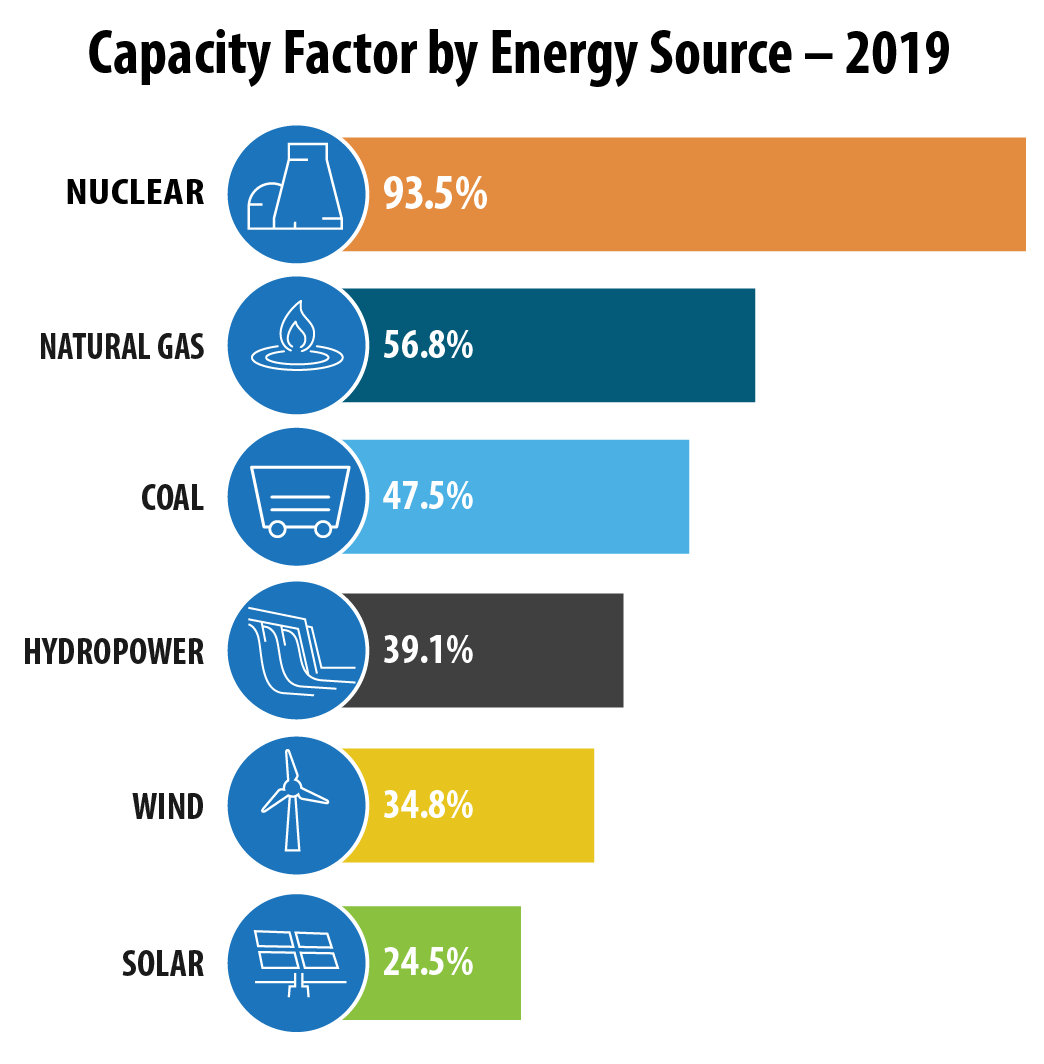
Source: energy.gov
Minimal, managed waste
Nuclear waste’s biggest problem is the prevailing belief that it is dangerous. Unlike other energy industries, nuclear takes full responsibility for its waste, also known as spent fuel, keeping it contained and secure so it doesn’t impact the environment. Nuclear fuel, as well as its waste, is also tiny in volume. All of the nuclear waste in the US could fit on a football field, stacked less than 10 yards high.
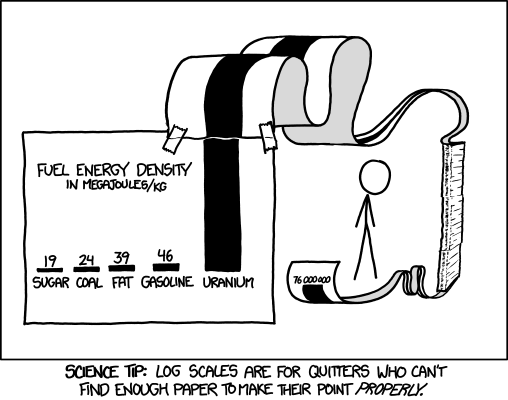
Source: XKCD
In addition, spent fuel can be recycled and used again as fuel in reactors. Regulation that stemmed from anti-nuclear weapons activism currently prevents the recycling of nuclear fuel in the United States, however the Department of Energy is supporting new reactor demonstrations that use recycled fuel, a positive sign that we may see things change here.
Finally, spent fuel has a perfect safety record — it has never killed or injured anyone and is safely contained on site at power plants. Air pollution from burning fossil fuels, for example, kills a million people prematurely each year worldwide.⁴ Solar panels produce 300x more toxic waste per unit of energy than nuclear, without any requirement to safely store this waste. Solar panels are therefore starting to end up in landfills, risking leaching toxic chemicals into groundwater.⁵
Secure
The term “carbon-free” has another implication: it simply doesn’t require carbon resources. Many countries have few or no carbon resources within their borders, so having energy sources that don’t rely on fossil fuel imports can make countries more energy secure. The more diverse one’s energy sources, especially when some are not local, the better. Germany, for example, relies far more than France on imported fossil fuels, and thus has been more impacted by the global energy crisis shocks to the natural gas supply chain.
Safe
Nuclear is far safer than fossil fuels, particularly coal, and on par with renewables in terms of deaths per GW of power produced. Coal emits particulate matter that shortens lives, and deaths from fossil fuel accidents, e.g. natural gas pipeline explosions, far outnumber those of nuclear (as well as wind and solar, both also very safe). There have been no deaths in the US from commercial nuclear power, and relatively few abroad, especially when compared to other energy sources.
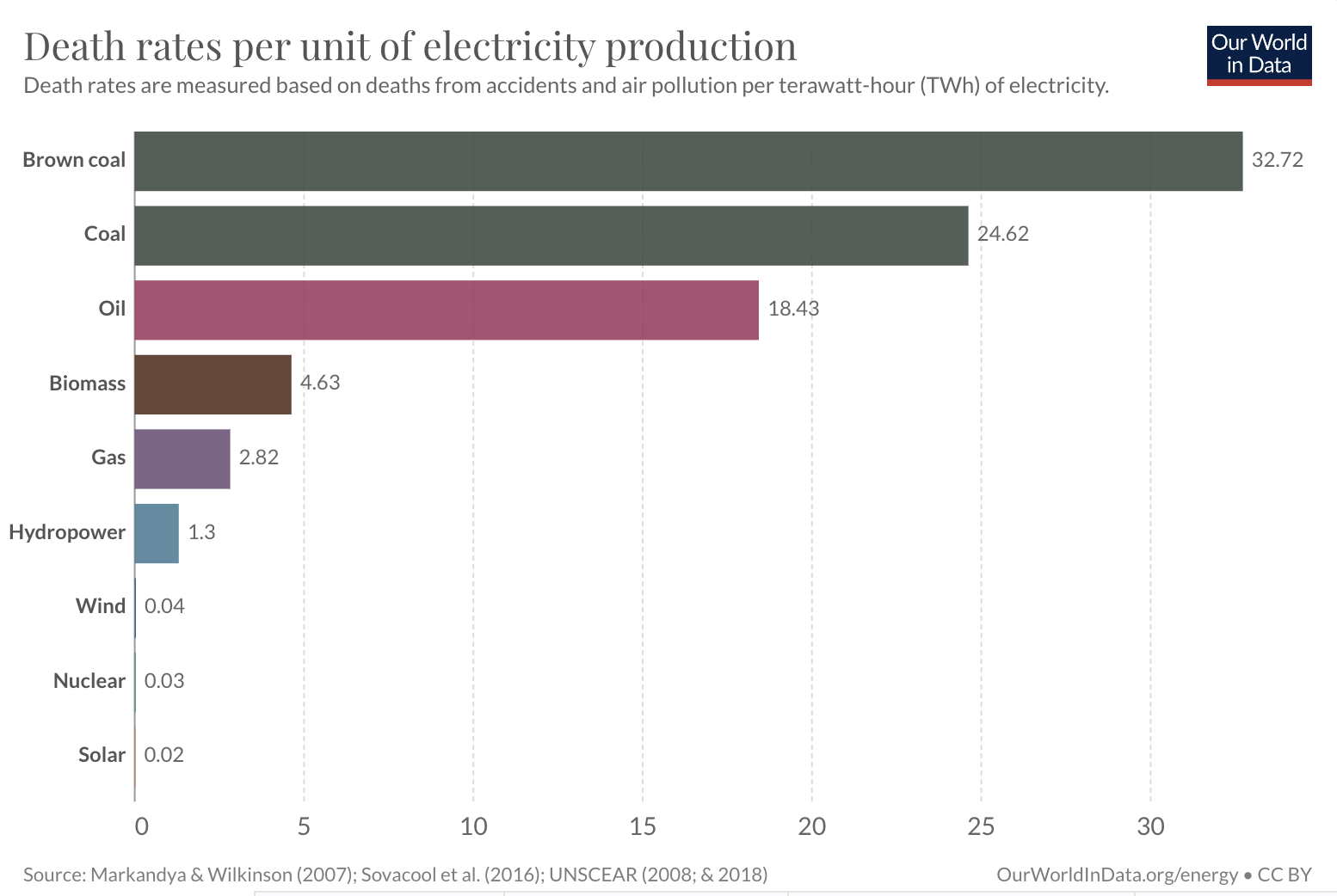 Source: Our World in Data
Source: Our World in Data
Space- and fuel-efficient
Nuclear energy can be produced in a very small footprint; a typical plant requires only about a square mile. In contrast, to produce the same amount of energy, wind requires 260–360x the amount of land, and solar requires 45–75x the amount of land.⁶ With such a small footprint, nuclear energy leaves a lot more land open for other purposes, including conservation.
3. Nuclear’s challenges
Nuclear is strongly positioned to deliver on the carbon-free and reliability features we want from our energy sources. Why is it not already the obvious answer, being aggressively built out across the US? Several major headwinds still exist: over-burdensome regulation, lukewarm public perception, limited government support, and cost to build.
Over-burdensome regulation
The nuclear industry’s regulatory body, the Nuclear Regulatory Commission (NRC), has a mandate to protect public health and safety as well as the environment. Inherent in this are incentives that make it incredibly risk-averse, with little reason to consider the cost-benefit trade-offs of things like the health impacts of nuclear versus coal, climate change, energy reliability, or energy security in their decision-making. This in turn means things like long timelines and burdensome quality assurance requirements are not seen as a bad thing, but instead might be viewed as constructive to a narrow, safety-oriented view.
More specifically, there are several specific areas where the NRC is overly slowing down or adding cost to the nuclear industry. First, the NRC requires the company who is getting regulated to pay for 90% of the cost of their regulatory review. This incentivizes lengthy review procedures with a large number of billable hours, since these fees pay for the operations and salaries of the commission.
Another major challenge with the NRC’s regulatory framework is their basis in a flawed radiation framework called Linear No Threshold (LNT) that dramatically overstates the impact of low-dose radiation. The way the LNT guidelines manifest is through their As Low As Reasonably Achievable (ALARA) guidance, which requires nuclear power plants to take extreme measures to reduce any possible chance of radioactivity exposure, leading to enormous cost implications in the design and building standards. The nuclear power complex, beholden to these standards, now feeds at the public trough, requiring billions of taxpayer and utility customer dollars to meet these nonsensical “gold standard” regulations.
Finally, the NRC still lacks a regulatory framework for advanced reactors and small modular reactors (SMRs), making it difficult for companies to understand how they will be regulated so they can design their reactors and prepare their application documents accordingly.
Lukewarm public perception
The public is divided in its support of nuclear energy, with roughly half of Americans in favor, half in opposition. Polling shows that Republicans and GOP-leaning independents are 10 percentage points more likely than Democrats/lean-D (42% vs. 32%) to say the federal government should encourage the production of nuclear power. However, Democrats and climate advocates are slowly increasing their support for nuclear and its part in the climate agenda, with a majority of Americans supporting a diversified energy strategy rather than calling for 100% renewables.
Fortunately, public figures are also starting to change their tune on nuclear. Climate activist Greta Thunberg for the first time recently came out in support of nuclear, calling it “a mistake to close down plants to focus on coal.” The Secretary of Energy Jennifer Granholm and nuclear influencer Isodope are additional voices in the mix, calling for more nuclear as a solution to our clean, firm power needs.
Finally, some government support
Building and operating nuclear power plants have historically required high upfront costs with long payback timelines, and are thus difficult to finance for all but the largest, most well-capitalized corporations or government entities. China’s nuclear industry, for example, benefits from the central planning and financial support of its national government. China has committed to break ground on 150 new reactors in the next 15 years (it currently has 53), and has 23 under construction today.
Similarly, all of France’s nuclear plants, which supply ~70% of the country’s electricity, are owned and operated by EDF, the vertically integrated electricity company now wholly owned by the French government. Operating in a more deregulated, free market economy such as the United States can make the math for nuclear more difficult, particularly due to the enormous upfront capital required to build a new plant.
The U.S. has historically extended limited support to the nuclear industry, particularly as it relates to building and operating plants (decommissioning, however, was subsidized). Renewables have secured far more support by way of tax credits and subsidies. Between 2011 and 2016, renewable energy received more than three times as much help in federal incentives as oil, natural gas, coal, and nuclear combined, and 27 times as much as nuclear energy.
However, the Inflation Reduction Act was a breakthrough for the nuclear industry in terms of federal funding. For the first time ever, existing nuclear reactors are now eligible for production tax credits, similar to those extended to renewables. However, the nuclear industry is still not on a level playing field with renewables based on the amount of subsidies they’ll receive. The IRA has earmarked $30B for nuclear, which produces 20% of US electricity, and $127B for wind and solar, which produces 12% of US electricity.
Sky-high costs and delays
Building in the real world is hard, and we’ve gotten worse at it. New York’s Second Avenue subway and California’s high-speed rail project are just two of many examples of billions in spend with little to show for it. Nuclear power plants are no different — they are massive, bespoke, complex engineering projects held to rigorous regulatory standards. Getting a reactor built on time and on budget is the exception rather than the norm, and we’ve lost the muscle for how to build them.
Given the atrophied state of the nuclear industry and the historic lack of government support, it shouldn’t come as a surprise that the US has only seen 2 new sets of reactors break ground since 1985. Fast forward to today and only one, Vogtle in Georgia, is scheduled for completion. Regrettably, Vogtle hasn’t painted the rosiest of pictures. It’s coming in at ~$30B, nearly double the initial budget, and at 6+ years behind schedule.
Economic feasibility has been one of the biggest barriers to building new nuclear. More on what we can do to fix this in the next section.
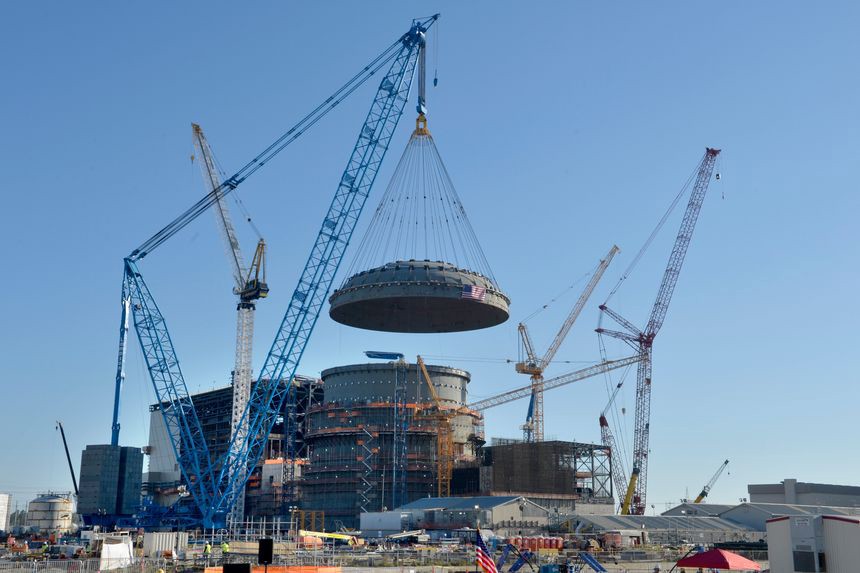
Vogtle Plant in Georgia, completed in 2022, 6 years late, with a budget of almost $30B
4. The Vision is Fission
Between emissions goals to combat climate change and the increasing demand for electricity across the US and worldwide, nuclear energy is well-positioned to establish itself as a smart long-term choice for firm, clean energy. And it’s critical we get moving right away – the nuclear industry has been dormant for too long. How can we start building more nuclear again?
We need several pieces to come together so that nuclear can provide us with abundant, clean, reliable energy: 1) regulatory reform, 2) more government support, 3) more public support, and 4) innovative nuclear companies (particularly working on small modular reactors).
Regulatory reform
The NRC is often cited as one of the top bottlenecks in progress towards building more nuclear. As discussed above, it has high fees and long timelines, disputed frameworks for how it regulates radiation, and finally, a lack of regulatory framework for advanced reactors, including SMRs. Here are a few ways to reduce these bottlenecks:
- Fee reform: the NRC itself cites a price tag of between $45 million and $70 million for new reactor design licensing, but with even more novel designs being proposed, this could be even higher. This is before companies are even close to being revenue-generating, making it an enormous hurdle for innovation. Fee reform has been proposed by members of Congress to reduce the upfront burden on companies looking to innovate in the nuclear space. While some skin in the game is useful for companies to have when asking for regulators time, there is ample room to drastically reform and reduce NRC fees.
- Specify a radiation threshold: the LNT framework has been disputed and is considered false by many credible sources. The NRC should establish an actual numerical threshold for what amount of radiation they consider acceptable, instead of using the ALARA framework that requires that any dollar that can be spent to reduce radiation must be spent, needlessly driving up costs. Legislative action might be the most effective way to ensure this framework change, since just last year the NRC shut down a proposal to abandon the LNT framework for a more scientifically sound one.
- Ship the advanced reactor framework: the NRC’s current regulatory framework is not designed for advanced reactors, and in 2019 Congress passed legislation known as NEIMA to require that the NRC create a framework for advanced reactors. However, more than 3 years later, there is still no framework in place, making it difficult for those developing advanced reactors to have clarity on how they might be regulated. Efforts to advance progress on the framework, with collaboration from industry, is critical to unblocking progress in developing new nuclear.
Government support
From the DOE’s Advanced Reactor Demonstration Program, started in 2020, to the restart of a nuclear waste siting program in 2021, to the new nuclear subsidies included in the Inflation Reduction Act in 2022, among many other initiatives, there is a lot to be excited about from the US federal government as it relates to nuclear.
However, there are still few vocal champions for nuclear energy among our political leaders. State and local leaders in particular are quick to come out in favor of renewables (or fossil fuels, depending on what side of the aisle they are on), but few mention nuclear. In addition, there has been a lot of funding for nuclear demonstration projects and research, but less towards commercializing nuclear. A few ways we can bolster government support for nuclear:
- Remove state nuclear moratoriums: there has been progress on removing state moratoriums, such as Montana in 2021 and West Virginia in early 2022, however there are 12 states that still have a moratorium in place. Lifting these to allow for new nuclear would signal a seriousness about nuclear in our energy agenda.
- Expand nuclear reactor test sites and test loops: the Advanced Test Reactor at the Idaho National Lab has one test loop (and is working on adding a second now) for testing new nuclear fuels, with a lengthy waiting list for getting access. Meanwhile, Russia has 8 and China has 9, allowing them a much faster pace of innovation. We need more test infrastructure to enable faster commercialization of new technologies.
- Structure DOE programs to support commercialization: the COTS program that SpaceX leveraged to develop its rocket would be a great model for the DOE to replicate to help support the development and commercialization of advanced reactors. The COTS program funded SpaceX and others to develop capabilities that they could then sell to the government longer term, providing the funding along the way only if they met business and technical milestones. Today’s DOE has funding for advanced reactor demonstrations, but not the full path to commercial success, which would help ensure these new technologies actually get to market.
Public support for nuclear
While there has been a slow turning of the tide on nuclear, there is still almost half of the US that opposes nuclear. Public opinion impacts local legislators in particular, who make decisions about what gets built, or shut down, so it’s critical that the public become more informed on nuclear energy.
- Double down on education and advocacy: encouragingly, polling also shows that the more informed people feel, the more supportive of nuclear they are. 68% of those who feel “very informed” about nuclear are strongly in favor, while only 8% are in favor among those who feel “not at all informed.” As nuclear energy gets discussed further, we should hopefully see public attitudes shift in favor of nuclear.
- Adopt and evangelize new environmental impact standards: unfortunately, some major environmental groups such as the Sierra Club grade legislators on their “environmental record,” with negative points for supporting nuclear. Legislators value this rating as a signal to their voters that they are environmentally conscious, making it more difficult for them to support nuclear. We need to build and use a new framework for evaluating our leaders’ environmental impact.
New nuclear: small modular reactors
Cost is the biggest hurdle for new nuclear, and small modular reactors are one of the most promising avenues for bringing cost/MWh down to make it more competitive with other energy sources. There are several startups and larger companies working on developing SMRs, some using light-water technology, some using molten salt or other moderators and coolants.
- Start building small modular reactors as quickly as possible: SMRs’ modular nature means that they can be produced at scale in a factory setting and then transported to their operating location, instead of building them as one-off, bespoke projects on site, the way reactors are currently built. There is huge opportunity for this format to reduce cost significantly, allowing nuclear to be more cost competitive with a shorter payback period. In addition, the ability to have smaller reactors in a variety of sizes allows for different applications, such as privately owned nuclear reactors for industry or remote communities. Companies developing small modular reactors include, but are not limited to:
- Oklo: building a small fast-neutron breeder reactor using high-assay low-enriched uranium; was rejected in its initial design application in January 2022 from the NRC
- Last Energy: building a small pressurized water reactor in a modular format, looking overseas first for their go-to-market
- NuScale: first company to receive a design license from the NRC for their small light water reactor design
- X-Energy: developing the Xe-100, received DoD funding in 2019 to develop small reactors for the military
- Radiant: ex-SpaceX team developing a portable microreactor
- Kairos Power: small reactor that leverages TRISO fuel combined with a low-pressure fluoride salt coolant
- Encourage the build out of other business models and the nuclear supply chain: With the new IRA subsidies and DOE funding, we may see existing companies shift their business models as well, for example from focusing solely on decommissioning to operating plants, which Holtec may consider doing with the Palisades plant. They are also designing their own SMR. This funding and renewed interest in nuclear energy will also lead to growth throughout the nuclear supply chain, from fuel sources to mining to vendors across the supply chain.
5. Closing Thoughts
No energy source should be studied in a vacuum. Nuclear is no exception.
When surveying the broader energy landscape and formulating a thesis on what we should prioritize and why, it’s clear that we need to strike a balance between pragmatism – low energy prices that don’t put our economy at risk, a reliable energy mix that doesn’t put our grid at risk of surges and undersupply – and ideology – we need to decarbonize for the sake of our planet’s future.
What, then, does a practical approach to decarbonization look like?
It looks like more electrification, where there are more efficient, cost-effective substitutes for fossil fuels. It will involve expansion of storage to complement renewables: batteries can release stored energy when the sun is not shining and wind is not blowing and thus help eliminate some of the intermittency that threatens grid stability. Renewables will then have a path to growing to a more significant percentage of our energy mix, without causing grid disruption, but the jury is still out on just how much of the grid renewables make sense to power.
Hydrogen, carbon capture, fusion, geothermal, and other new technologies should also be researched to understand what kind of role they could play in decarbonization, and at what price and with what trade-offs.
As far as fossil fuel reduction goes, a clear place to start would be reducing reliance on coal, the most polluting of the major energy sources. A recent DOE study identified 157 retired coal plant sites and 237 operating coal plant sites as potential candidates for a coal-to-nuclear transition.
However, it’s important to recognize that fossil fuels have lifted humanity out of poverty and are the root of the vast majority of what makes for our relatively comfortable lifestyles – from agriculture to transportation to heating to the built world. We must not fall into the trap of seeking to quickly eliminate fossil fuels at the expense of human flourishing, particularly by leaving those in the developing world stuck in energy poverty.
This leads us to nuclear: it has undeniable advantages as an energy source that is both carbon-free and reliable. In order to make use of this powerful technology, we must focus on public and government support, reforming our regulatory frameworks, and bringing costs down, so we can realize the full potential of nuclear energy.